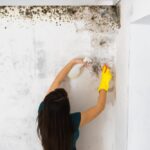Your home’s roof is undoubtedly the most important structure. It provides support, shelter, safety and provides space for guttering and other fittings. Roofs also add to the value of a property; a stylish roofing makes a house much more appealing.
However, roofs do require care and proper maintenance once they’re installed. If they’re left on their own, a silent attacker in the form of mould can cause quite a bit of damage.
What is Mould?
Moulds that form on roofs are usually a mix of algae, moss, moulds and sometimes, mildews.
- Algae is the black, dark and streaky mould-like structure that forms on roof shingles. It’s pretty harmless, although it may cause property damage if built-up is not treated.
- Moss is the fuzzy, dense, greenish organism that covers your roof, making it unappealing and dirty-looking.
- Mildew is a light grey-green found in warmer climates. Unlike others, it leaves a powdery residue and can be a health problem.
- Moulds are dark stains on roof. Their growth is an unhealthy occurrence and they tend to produce a horrible odour.
Why are Moulds created?

The main cause of mould growth is moisture. If you live in a warmer area, the chances of mould growth on your roof automatically increase. The air may carry spores to your roofing, and once the spores have settled, they start producing new moulds.
Algae and other forms of moulds are common in places where it rains frequently. The moisturized environment is ideal for algae to grow in. Moulds also appear in shady patches, especially under a tree or shrub.
Roofing made of wood or organic material is more likely to house moulds and blue-green algae. Leakage from guttering can also cause microorganism growth.
Harmful Effects of Moulding:
People are typically unaware of the harms caused by moulding. Yes, it affects the overall aesthetics of your roof, but there are a number of other harmful effects!
- First and foremost, algae and moulds damage the roofing. These organisms eat away at the minerals and organic compounds present in your shingles, whose repair may cost you good money.
- Moulds and algae cover your roof in dark, dense spots. These spots absorb sunlight, causing heat radiation to increase. In other words, the roof will get hotter as the algae grows. The heat trapping can make you uncomfortable and increase the energy consumption of air-conditioning.
- Lastly, moulds carry a health risk. They can grow inside your air conditioning vents and exhausts, causing respiratory issues. Their spores can cause eye irritation, coughing and asthma. Eliminating these risks is very important.
Tips to Prevent Moulding:
If you want to avoid mould formation and future problems, we have a few solutions:
- Keep branches of trees away from your roof. Their shade slows down water evaporation, and stagnant water acts as a breeding centre for growth of microorganisms.
- Use copper shingles. Copper and zinc are lethal to most moulds. You can either replace your shingles, or place strips of copper and zinc below the shingles near the peak, leaving a few inches exposed to the weather. That way, rainwater can carry the minerals to potential mould spores and kill them.
- Clean your gutters. This prevents chances of leakage and clogging. Clogged water also acts as a ground for microbial activity.
Apply chemical barriers. You can choose eco-friendly chemicals that keep your shingles safe from future attacks of moulds. - Replace shingles with darker tones. This isn’t a solution to avoid moulds, but it’s useful for those who want to hide unpleasant and unappealing algae stains.
How to Get Rid of Moulds:

If moulds have accumulated on your roofing, you can use the following tips to clean them:
- Never use pressure washers. Sure, they make the job easier, but they also damage the shingles. Using a hose with a nozzle attached is the best choice.
- To clear algae, use 1-part bleach mixed in 1-part water. Let the solution sit for an hour before you rinse the patch.
- If the algae streaks are too stubborn, try using trisodium phosphate. Mix the chemical in water (about 60-65 mL per 1L).
- You can visit the local shops and buy commercially available cleaners and acids. Make sure to read the label, which tells if a product is suitable for your roof material and paint.
A better solution would be contacting a professional roofing company. Their team of professionals will get rid of the moulding in no time!
Mould Cleaners in Essex:
The Essex, Kent and London areas see rain quite often. The humid environment is perfect for mould growth. If you live in the region, and are facing moulding build-up, Foley’s Roofing Specialists would gladly take care of the issue.
Foley’s Roofing Specialists are experts in everything related to roofing. They’re skilled in solving all issues of roofs in general. Foley’s Roofers offer a ton of services, from cleaning to entire installations. If you’re looking to replace your shingles or need an efficient roof cleaning service, call Foley’s Roofing Specialists.






